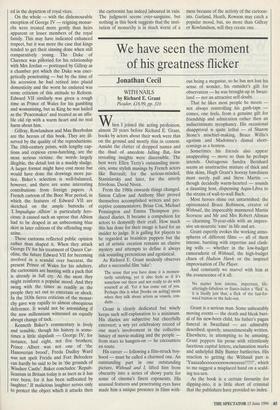Something or other doth hedge a king
Philip Ziegler
THE KINGS AND QUEENS: AN IRREVERENT CARTOON HISTORY OF THE BRITISH MONARCHY by Kenneth Baker Thames & Hudson, L15, pp. 192 Caricature, Kenneth Baker tells us, started in Italy in the 17th century: 'Malice was there from the start, as was the inten- tion to wound.' This collection shows how malice, if rarely wholly absent, has often been curbed and muted.
Queen Victoria, for instance, was cen- sured for her withdrawal from public life but otherwise left unscathed by the car- toonists. Partly, Baker believes, this was because newspapers made superfluous the scandalous prints of the 18th century and `the father of the household did not want his wife and daughters to see scurrilous and lewd cartoons in his drawing room'. This is certainly true, but, still more, the Queen's leadenly immaculate private life gave the cartoonist — used to feasting on the excesses of the Hanoverians — little to poke fun at. Nor did George V oblige by doing anything more outrageous than stick in stamps and butcher birds, while George VI was the despair of anyone who delight- ed in the depiction of royal vices.
On the whole — with the dishonourable exception of George IV — reigning monar- chs were treated more gently than heirs apparent or lesser members of the royal family. This may have indicated enhanced respect, but it was more the case that kings tended to get their sinning done when still comparatively young. The Duke of Clarence was pilloried for his relationship with Mrs Jordan — portrayed by Gillray as a chamber pot which the Duke was ener- getically penetrating — but by the time of his accession he had retired into placid domesticity and the worst he endured was some criticism of this attitude to Reform. Edward VII similarly was given a rough time as Prince of Wales for his gambling and womanising, but as King he was hailed as the 'Peacemaker' and treated as an affa- ble old rip with a warm heart and no real harm about him.
Gillray, Rowlandson and Max Beerbohm are the heroes of this book. They are ill- served by the quality of the reproductions. The 18th-century prints, with lengthy cap- tions and copious cross-hatching, are the most serious victims: the words largely illegible, the detail lost in a muddy sludge. A larger format might have cost more but would have done the drawings more jus- tice. Baker's selection is well-balanced, however, and there are some interesting contributions from foreign papers. A French cartoon of the Boer War period, in which the features of Edward VII are sketched on the ample buttocks of `L'Impudique Albion' is particularly fero- cious: it caused such an uproar that Albion had to be draped in an unbecoming blue skirt in later editions of the offending mag- azine.
These cartoons reflected public opinion rather than shaped it. When they attack George IV for his treatment of Queen Car- oline, the future Edward VII for becoming involved in a scandal over baccarat, the present Prince of Wales for his adultery, the cartoonists are hunting with a pack that is already in full cry. At the most they might reinforce a popular mood. And they swing with the times as readily as the people they set out to entertain or shock. In the 1830s fierce criticism of the monar- chy gave way rapidly to almost obsequious deference. It would not be astonishing if the new millennium witnessed an equally abrupt change of tack. Kenneth Baker's commentary is lively and sensible, though his history is some- times a little slapdash — George IV, for instance, had eight, not five brothers; Prince Albert was not one of 'the Hanoverian brood', Freda Dudley Ward was not spelt Freida and Fort Belvedere can hardly be said to be in 'the grounds of Windsor Castle'. Baker concludes: 'Repub- licanism in Britain today is as inert as it has ever been, for it has been suffocated by laughter.' If malicious laughter serves only to protect the object which it attacks then the cartoonist has indeed laboured in vain. The judgment seems over-sanguine, but nothing in this book suggests that the insti- tution of monarchy is in much worse of a mess because of the activity of the cartoon- ists. Garland, Heath, Rowson may catch a popular mood, but, no more than Gillray or Rowlandson, will they create one.



































































 Previous page
Previous page